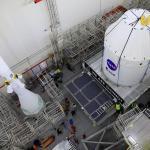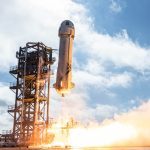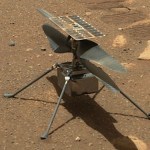Dominique Luchart's Blog, page 568
July 14, 2021
NASA prepares 1st moonbound Orion spacecraft to receive its launch abort system, ,

NASA’s new Orion space capsule is one step closer to returning to space, this time for a mission around the moon.
The U.S. space agency released photos of the moonbound spacecraft moving between buildings at the Kennedy Space Center in Florida as part of launch preparations for Artemis 1, which is targeting an uncrewed trip around the moon by the end of 2021.
On Saturday (July 10), Orion moved from a payload processing facility to another building where it will receive the launch abort system, and NASA’s Exploration Ground Systems Twitter channel documented the journey.
In photos: The Orion space capsule: NASA’s next spaceship
“These photos show @NASA_Orion arriving at and inside of the Launch Abort System Facility (LASF) at @NASAKennedy, where teams will add the launch abort system (tall & thin structure seen here) to the top of the spacecraft for the launch of @NASAArtemis I,” one of the tweets stated on Monday (July 12).
Orion, which is flying for the first time since an Earth-orbiting test in 2014, will be thrust into space by NASA’s unflown Space Launch System megarocket for deep-space destinations. SLS encountered several technical issues during testing in Mississippi in late 2020 and early 2021 before shipping to Florida. In June, NASA personnel stacked the SLS stages at Kennedy, and Orion is scheduled to go atop the rocket by the end of the summer.
See more
Artemis 1 will be a crucial uncrewed test of the moon program ahead of expected landings by astronauts. During the flight, Orion will swing around the moon carrying sensors and simulated human bodies to measure radiation and stress levels in deep space. Its “passengers” include a “moonikin” recently .
Following Artemis 1 will be a crewed mission around the moon called Artemis 2, perhaps as soon as 2023. A crewed landing may follow, which NASA is hoping to fly in late 2024. No astronauts have been publicly named for these missions, although a Canadian astronaut will fly around the moon on Artemis 2 as a thank-you for the country’s promise to build a Canadarm3 robotic arm for the forthcoming Gateway lunar space station.
[image error]
The Artemis 1 Orion capsule arriving to acquire its launch abort system at NASA’s Kennedy Space Center. (Image credit: NASA)In its $24.8 billion budget request for NASA, released in May, President Joe Biden’s administration suggested a 5% increase in funding for deep-space exploration systems to $6.88 billion; this budget line includes hardware for Artemis. At the time, NASA chief financial officer Steve Shinn said the landing missions could be delayed.
“I know the goal is 2024, but I think we have to be brutally realistic,” Shinn said in a news conference when the budget proposal was released. “Because space development is so hard, there could be delays to that schedule for the first demonstration flight of landing humans [on the moon] and returning them safely to Earth.”
Follow Elizabeth Howell on Twitter @howellspace. Follow us on Twitter @Spacedotcom and on Facebook.
Join our Space Forums to keep talking space on the latest missions, night sky and more! And if you have a news tip, correction or comment, let us know at: community@space.com.
The post NASA prepares 1st moonbound Orion spacecraft to receive its launch abort system, , appeared first on NEWDAWN Blog.
Telescope maker Unistellar teams up with camera giant Nikon to increase access to high-tech skywatching, ,
Telescope maker Unistellar and Nikon have announced a new partnership to give a wider public of amateur astronomers a chance to use high-end equipment and enjoy the wonders of the night sky just like astronomy professionals.
A lot of cameras used by astronauts to photograph the Earth from above on the International Space Station are made by Nikon, and through the partnership the optics icon will help Unistellar by sharing its cutting-edge technologies and industrial know-how, according to a July 7 announcement by the companies.
Related: These are the best astronomy images of 2021
“Like Nikon has done and continues to do in many fields related with optics and imaging, we see Unistellar’s products spark joy and excitement on an important and meaningful topic that was previously difficult to grasp for consumers,” Yasuhiro Ohmura, Nikon’s senior vice president, said in a statement.
“We are also especially sensitive to the unique way Unistellar promotes science and enlightenment at a popular level and are happy to collaborate in widening and furthering this mission.”
Both companies are aiming to promote knowledge, education and advancements in science as well as public participation in astronomy. Citizen scientists have helped full-time researchers detect , supernovas and exoplanets, among other accomplishments.
“The passion and drive of Nikon’s teams for our common projects has been incredible,” Unistellar CEO Laurent Marfisi said in the same statement. “We can’t wait to reveal our future products to the public and how they will accelerate the New Astronomy revolution.”
Follow us on Twitter @Spacedotcom or Facebook.
Join our Space Forums to keep talking space on the latest missions, night sky and more! And if you have a news tip, correction or comment, let us know at: community@space.com.
The post Telescope maker Unistellar teams up with camera giant Nikon to increase access to high-tech skywatching, , appeared first on NEWDAWN Blog.
Video of Richard Branson’s desert bike ride was recorded before Unity 22 launch day, Virgin Galactic clarifies, ,

A Virgin Galactic video of founder Richard Branson’s bike ride ahead of his launch into space on the company’s Unity 22 mission in New Mexico this week was actually recorded and did not occur on the same day as the flight, the company clarified today..
The video showed Branson, who is famous for athletic activities, riding a bike toward Spaceport America near the town of Truth and Consequences, New Mexico. That was the site where Virgin Galactic VSS Unity spaceliner safely took off and landed with Branson and five other crew members aboard on Sunday (July 11) in a milestone test flight for the company. A caption on the video suggested that it happened “Earlier Today” and it was noted by webcast commentators, but that was an error, Virgin Galactic said.
“The footage of Sir Richard Branson shown during the event today [July 11] was prerecorded and misidentified in the broadcast. We regret the error and any confusion it may have caused,” Virgin Galactic representatives said in a statement emailed to Space.com. Space.com reported on the video on launch day and has corrected its story.
Related: Virgin Galactic launches Richard Branson to space in 1st fully crewed flight More: ‘Welcome to the dawn of a new space age,’ Branson says
[image error]
Virgin Galactic founder Richard Branson rides a bike to Spaceport America ahead of his launch on the Unity 22 mission on July 11, 2021. (Image credit: Virgin Galactic)A Reuters report, quoting an anonymous source from Virgin Galactic, said the video was filmed on July 5 and Branson was not on his bike on launch day. The bicycle video clip was also posted to Branson’s Twitter feed shortly before the launch.
Branson also told spectators about the bike ride during a post-flight celebration at the spaceport, Reuters said. “It’s so awesome to arrive on a bicycle, across this beautiful New Mexico countryside,” Branson was quoted as telling the crowd from a stage.
The Branson flight by Virgin Galactic is part of the company’s bid to open seats to paying space tourists in the coming months. The 70-year-old Branson founded the company in 2004 and has been wanting to go to space since July 1969, when he saw the Apollo 11 astronauts landing on the moon.
Follow Elizabeth Howell on Twitter @howellspace. Follow us on Twitter @Spacedotcom and on Facebook.
Join our Space Forums to keep talking space on the latest missions, night sky and more! And if you have a news tip, correction or comment, let us know at: community@space.com.
The post Video of Richard Branson’s desert bike ride was recorded before Unity 22 launch day, Virgin Galactic clarifies, , appeared first on NEWDAWN Blog.
Loki finale confirms second season, Jon Porter
Disney’s Loki TV show is getting a second season, according to a scene appended to the sixth and final episode of its first season. The confirmation, first spotted by Variety, comes mid-way through the episode’s credits at the 42 minute and 48 second mark, when a stamp appears on screen which simply reads “Loki will return in season 2.”
Loki is the third Marvel show to have premiered on Disney Plus, and the first to have had a second season officially confirmed. WandaVision star Elizabeth Olsen has confirmed that the show, which premiered in January this year, isn’t due to receive a second season. Meanwhile it’s currently unclear whether The Falcon and the Winter Soldier will return for a second season, especially given the show leads neatly into the upcoming fourth Captain America movie.
It’s currently unclear when the second season of Loki will release, but Variety notes that the last episode of its first season leads into the upcoming Marvel film Dr. Strange in the Multiverse of Madness, which is due to release March 2022. Loki season 2 joins a host of other Marvel shows announced for Disney Plus including Hawkeye, Ms. Marvel, She Hulk and an untitled series focused around Wakanda from the Black Panther franchise.
The post Loki finale confirms second season, Jon Porter appeared first on NEWDAWN Blog.
Retail stores are packed with unchecked facial recognition, civil rights organizations say, Dave Gershgorn

More than 35 organizations are demanding top US retailers cease using facial recognition to identify shoppers and employees in their stores, which companies have used to deter theft and identify shoplifters.
The campaign is aptly named Ban Facial Recognition in Stores, and has identified stores that have committed to not using facial recognition, like Walmart, Home Depot, and Target. It is now pressuring companies currently using the technology, or those who might use it in the future. Some companies that are currently using the technology, according to the website, include Apple, Lowe’s, Albertsons, Macy’s, and Ace Hardware.
Companies that might use it in the future include McDonalds, Walgreens, and 7-Eleven. A full list can be found on the website.
Privacy non-profit Fight for the Future organized the campaign last month as part of its larger Ban Facial Recognition project, and but has now garnered support from civil rights organizations like Mijente, Public Citizen, and Data for Black Lives, as well as others like the Consumer Federation of America and the Tor Project. Notably, facial recognition company Kairos, which touts itself as an ethical vendor of the tech, has also signed onto the campaign.
Tawana Petty, the national organizing director at Data for Black Lives, explains in the campaign’s press release that Detroit has implemented Project Green Light, which places surveillance cameras with facial recognition in more than 700 businesses.
“These cameras using facial recognition are monitored at real-time crime centers, police precincts, and on officers’ mobile devices 24/7,” she said. “It’s difficult to explain the psychological toll it takes on a community, knowing that your every move is being monitored by a racially biased algorithm with the power to yank your freedom away from you.”
Retailers have used invasive technologies like products that ping your phone’s Bluetooth and then catalog its unique MAC address, but AI-powered upgrades to video surveillance systems have allowed features like facial recognition to be more accessible than ever.
For instance, Rite-Aid quietly installed facial recognition cameras in hundreds of US stores, mostly in non-white and lower-income neighborhoods, Reuters reported in July 2020. The cameras scanned shoppers’ faces to try and find people in the store who were previously suspected of criminal activity and then sent alerts to security.
Walmart also reportedly used Clearview AI’s facial recognition more than 300 times, according to BuzzFeed News, and had previously used the technology to try and catch shoplifters. Now, it seems to be taking a different approach by using AI to find un-scanned goods in self-checkout kiosks.
Since these stores are private property, companies are not bound by state or local regulations banning government use of facial recognition which have been the most popular form of regulation. Only Portland, Oregon has included private businesses in a facial recognition ban.
Fight for the Future also points out that the coronavirus pandemic has expanded the use of facial recognition-adjacent surveillance in stores, which includes software for customer counting and social distancing.
The post Retail stores are packed with unchecked facial recognition, civil rights organizations say, Dave Gershgorn appeared first on NEWDAWN Blog.
July 13, 2021
A lander on Jupiter’s icy moon Europa may have to dig at least 1 foot down to find signs of life, ,

Robots may have to dig relatively deep on Jupiter’s icy moon Europa to have a shot of finding signs of life, a new study suggests.
Scientists think Europa harbors a huge ocean of liquid water beneath its icy shell. This ocean appears to be in contact with the 1,940-mile-wide (3,100 kilometers) moon’s rocky core, making possible a range of complex chemical reactions. As a result, Europa is generally regarded as one of the solar system’s best bets to harbor alien life.
If life has ever existed on Europa, some signs of it may bubble out of that buried ocean onto the surface, where robots could potentially spot it. Well, not right on the surface; Europa gets hammered hard by charged particles, which are trapped and accelerated by Jupiter’s powerful magnetic field.
Photos: Europa, mysterious icy moon of Jupiter
Previous work has suggested that just 8 inches (20 centimeters) of ice could likely shield any biomolecules that might exist on Europa from that punishing radiation environment, even in the hardest-hit regions of the moon.
The new study, which was published Monday (July 12) in the journal Nature Astronomy, is a bit more pessimistic. In it, researchers modeled how Europa’s surface is distubed by small but frequent impacts — a real issue for a world without a substantial atmosphere to burn up incoming hunks of rock and ice.
They found that such “impact gardening” likely churns the top 12 inches (30 cm) or so of Europan ice significantly, bringing previously buried bits up to the surface, where radiation can zap any interesting molecules into unrecognizable goo.
“If we hope to find pristine, chemical biosignatures, we will have to look below the zone where impacts have been gardening,” study lead author Emily Costello, a planetary research scientist at the University of Hawaii at Manoa, said in a statement. “Chemical biosignatures in areas shallower than that zone may have been exposed to destructive radiation.”
The new work is likely of interest to NASA, which plans to launch a Europa spacecraft in 2024. The mission, called Europa Clipper, will orbit Jupiter but study the moon and its buried ocean over dozens of close flybys.
Clipper’s many duties also include scouting out potential touchdown sites for a life-hunting lander — a mission that Congress has directed the agency to mount but which remains a concept for now.
Mike Wall is the author of “ Out There ” (Grand Central Publishing, 2018; illustrated by Karl Tate), a book about the search for alien life. Follow him on Twitter @michaeldwall. Follow us on Twitter @Spacedotcom or Facebook.
Join our Space Forums to keep talking space on the latest missions, night sky and more! And if you have a news tip, correction or comment, let us know at: community@space.com.
The post A lander on Jupiter’s icy moon Europa may have to dig at least 1 foot down to find signs of life, , appeared first on NEWDAWN Blog.
We want to see your internet bill, Russell Brandom

You don’t always get what you pay for in internet access. Most places only have one option, so you’re stuck picking the good plan or the bad plan from a single carrier, and if the expensive “broadband” plan turns out to be closer to dial-up speeds, there isn’t much you can do. And that’s without getting into the big swaths of the country that don’t even have a broadband option on the table.
So we’re joining with Consumer Reports to take a close look at the problem, collecting as many internet bills as we can to get a sense of which telecoms are holding up their end of the bargain — and which ones are falling short. The idea is to get a bird’s-eye view of the speeds people are actually getting, and what they’re paying for those speeds.
To get there, we want to take a look at your internet bill. Consumer Reports has put together a site to collect your information and do a quick speed test. The whole thing should take about seven minutes, and you’ll be doing your part to build a better internet.
A few quick notes on privacy: your bill will be encrypted as soon as you update it, and Consumer Reports has pledged to only record relevant data such as price, bundle, speed, and hidden fees, and they’ll delete bills when they’re no longer needed. The site will ask you to create a login as a way to keep the information private and safe, but you won’t have to pay for anything and no personally identifiable information will be shared with outside researchers. You can get more answers about the specifics here.
We’re hoping this project will give us tens of thousands of bills to pore through, and spur on some great investigations for later on in the year. So head over to the site and show us your bill — and in a few months, we’ll tell you what we found.
The post We want to see your internet bill, Russell Brandom appeared first on NEWDAWN Blog.
Blue Origin will launch billionaire Jeff Bezos into space on July 20. Here’s how to watch., ,

Blue Origin’s New Shepard rocket is counting down for its first crewed flight on July 20, when it will launch company founder Jeff Bezos and three others into space, and you can watch the whole thing live.
The launch of New Shepard’s first crewed flight will be broadcast beginning at 7:30 a.m. EDT (1130 GMT) at BlueOrigin.com and at Space.com. Liftoff is scheduled for 9 a.m. EDT (1300 GMT), but that will depend on the weather forecast and other technical factors.
A typical New Shepard flight lasts 11 minutes, and a live broadcast with the astronauts will be available at BlueOrigin.com after the landing, Blue Origin said in a press release Monday (July 12). The company will also be sharing mission updates all day via @BlueOrigin on Twitter.
Related: Jeff Bezos will join passengers launching into space on Blue Origin’s 1st crewed flight
Riding along with Bezos will be Mercury 13 aviator Wally Funk, whom he personally invited to join the crew, along with his brother Mark and a so-far anonymous auction winner who paid $28 million for a seat.
The New Shepard rocket and capsule will launch from Launch Site One, a remote area in the west Texas desert that will be closed to all spectators, even along nearby sections of State Highway 54, Blue Origin said.
Bezos (best known for creating Amazon) founded Blue Origin in 2000 with the hopes of eventually bringing rich space tourists to suborbital space. Sheer altitude has become one of the points in which Blue Origin hopes to differentiate itself from competitor Virgin Galactic, which was founded in 2004 and just launched its own billionaire founder Richard Branson on Sunday (July 11).
[image error]
A New Shepard launch conducted in December 2019. (Image credit: Blue Origin)Days before Branson’s flight, Blue Origin released an infographic snarkily comparing the two systems and criticizing Virgin Galactic’s design decision to fly below the Karman line, the 62-mile (100 kilometers) mark that is internationally recognized as the boundary of space. That said, all Virgin Galactic astronauts do soar well above 50 miles (80 km), the demarcation point recognized by NASA, the U.S. military and the Federal Aviation Administration.
The billionaire vs. billionaire battle of Branson and Bezos has also prompted a wider discussion about affordability of space tourism, although some people of more ordinary means like Funk have been comped a seat aboard early flights. A typical seat on Virgin Galactic costs $250,000; usual per-seat pricing for New Shepard as not yet been revealed.
Follow Elizabeth Howell on Twitter @howellspace. Follow us on Twitter @Spacedotcom and on Facebook.
Join our Space Forums to keep talking space on the latest missions, night sky and more! And if you have a news tip, correction or comment, let us know at: community@space.com.
The post Blue Origin will launch billionaire Jeff Bezos into space on July 20. Here’s how to watch., , appeared first on NEWDAWN Blog.
A ‘wobble’ in the moon’s orbit could result in record flooding in the 2030s, new study finds, ,

Climate change has already increased the frequency and severity of hurricanes and other extreme weather events around the world. — But there’s a smaller, less splashy threat on the horizon that could wreak havoc on America’s coasts.
High-tide floods, also called “nuisance floods,” occur in coastal areas when tides reach about 2 feet (0.6 meters) above the daily average high tide and begin to flood onto streets or seep through storm drains. True to their nickname, these floods are more of a nuisance than an outright calamity, inundating streets and homes, forcing businesses to close and causing cesspools to overflow — but the longer they last, the more damage they can do.
The U.S. experienced more than 600 of these floods in 2019, according to the National Oceanic and Atmospheric Administration (NOAA). But now, a new study led by NASA warns that nuisance floods will become a much more frequent occurrence in the U.S. as soon as the 2030s, with a majority of the U.S. coastline expected to see three to four times as many high-tide flood days each year for at least a decade.
The study, published June 21 in the journal Nature Climate Change, warns that these extra flood days won’t be spread out evenly over the year, but are likely to cluster together over the span of just a few months; coastal areas that now face just two or three floods a month may soon face a dozen or more.
These prolonged coastal flood seasons will cause major disruptions to lives and livelihoods if communities don’t start planning for them now, the researchers cautioned.
“It’s the accumulated effect over time that will have an impact,” lead study author Phil Thompson, an assistant professor at the University of Hawaii, said in a statement. “If it floods 10 or 15 times a month, a business can’t keep operating with its parking lot under water. People lose their jobs because they can’t get to work. Seeping cesspools become a public health issue.”
Several factors drive this predicted increase in flood days.
For one, there’s sea level rise. As global warming heats up the atmosphere, glacial ice is melting at a record pace, dumping enormous amounts of meltwater into the ocean. As a result, global average sea levels have risen about 8 to 9 inches (21 to 24 centimeters) since 1880, with about a third of that occurring in just the last 25 years, according to NOAA. By the year 2100, sea levels could rise anywhere from 12 inches (0.3 m) to 8.2 feet (2.5 m) above where they were in 2000, depending on how well humans restrict greenhouse gas emissions in the coming decades.
While rising sea levels alone will increase the frequency of high-tide floods, they will have a little help from the cosmos — specifically, the moon.
The moon influences the tides, but the power of the moon’s pull isn’t equal from year to year; the moon actually has a “wobble” in its orbit, slightly altering its position relative to Earth on a rhythmic 18.6-year cycle. For half of the cycle, the moon suppresses tides on Earth, resulting in lower high tides and higher low tides. For the other half of the cycle, tides are amplified, with higher high tides and lower low tides, according to NASA.
We are currently in the tide-amplifying part of the cycle; the next tide-amplifying cycle begins in the mid-2030s; — and, by then, global sea levels will have risen enough to make those higher-than-normal high tides particularly troublesome, the researchers found.
Through the combined effect of sea-level rise and the lunar cycle, high-tide flooding will increase rapidly across the entire U.S. coast, the team wrote. In a little more than a decade, high-tide flooding will transition “from a regional issue to a national issue with a majority of U.S. coastlines being affected,” the authors wrote. Other elements of the climate cycle, like El Nino events, will cause these flood days to cluster in certain parts of the year, resulting in entire months of unrelenting coastal flooding.
Scary as this pattern sounds, it is also important to understand for planning purposes, the authors wrote.
RELATED CONTENT
Images of melt: Earth’s vanishing ice
The reality of climate change: 10 myths busted
“Understanding that all your events are clustered in a particular month, or you might have more severe flooding in the second half of a year than the first — that’s useful information,” study co-author Ben Hamlington of NASA’s Jet Propulsion Laboratory said in the statement.
Extreme weather events may get all the national media attention as they batter America’s coasts, but high-tide flooding will soon be impossible to ignore. Best to start planning for it now, before it’s too late, the authors concluded.
Originally published on Live Science.
The post A ‘wobble’ in the moon’s orbit could result in record flooding in the 2030s, new study finds, , appeared first on NEWDAWN Blog.
NASA is mapping out plans for bigger, more capable Mars helicopters, ,

Given the highly successful and ongoing flights of NASA’s Ingenuity Mars helicopter, engineers are turning their attention to future aerial craft for the Red Planet.
One concept is the Mars Science Helicopter, advocated as a way to greatly expand the exploration zone on Mars — including possible deep dives into Red Planet caves.
Researchers have already gleaned loads of technical information from Ingenuity’s off-Earth flights, steadily pushing its capabilities. Now they want to use that data to push for development of a new aerial system for Mars investigation.
Video: Watch NASA’s Mars helicopter Ingenuity fly in 3D
[image error]
NASA’s Mars helicopter Ingenuity was designed to help pave the way for more capable Red Planet rotorcraft. (Image credit: NASA/JPL-Caltech)Blow the doors open“Ingenuity is a technology demonstrator. Our core goal, our prime directive, is to prove that we can fly on Mars…to have that Wright Brothers moment for the first time and hopefully blow the doors open for the future exploration capabilities on the Red Planet,” said Ingenuity operations lead Theodore Tzanetos of NASA’s Jet Propulsion Laboratory (JPL) in Southern California.
Tzanetos provided a review of Ingenuity’s flights to date and a preview of future sorties, and he also laid out the basics of a possible follow-on Mars aircraft. He spoke during a June 21 virtual gathering of the Mars Exploration Program Analysis Group (MEPAG), which is responsible for providing science input needed for NASA to plan and prioritize Mars exploration activities.
Ingenuity came into being thanks to a small but passionate team, Tzanetos emphasized, that involved JPL, AeroVironment, Inc., NASA’s Ames Research Center in Silicon Valley, Qualcomm, NASA’s Langley Research Center in Virginia, and SolAero.
Since Ingenuity’s first flight on April 19, “we have been collecting a treasure trove of engineering data,” Tzanetos said. “Every one of the flights afterwards was built on that [first] success.”
As of Tuesday (July 13), Ingenuity has flown nine times on the Red Planet.
Extended missionIngenuity made its debut flight in April, a roughly 30-second affair from takeoff to landing. The little chopper aced four additional flights over the next few weeks, wrapping up its original technology-demonstration mission in early May.
Ever since then, the craft has been flying in an extended mission phase designed to show the scouting potential of Mars helicopters. The plan calls for flying around two times a month, with a smaller team of operators here on Earth.
“The focus is to try and become as efficient as possible,” Tzanetos said during his MEPAG talk. “We’re really starting to stretch our wings, so to speak, in the distances, flight times and height above ground level.”
Meanwhile, flights of the Mars airborne machine have yielded other firsts. One of those is use of the copter’s navigation imagery melded with NASA’s Mars Reconnaissance Orbiter images of Jezero Crater, where Ingenuity touched down with NASA’s Perseverance rover this past February.
Doing so showcased that Ingenuity is able to produce high-resolution imagery downfield. For example, Ingenuity operators found, after the fact, that color images of Jezero’s Seitah geologic unit — a sandy stretch of terrain that is viewed as tough for Perseverance to traverse — led to “serendipitous science targeting” of value to rover operators, Tzanetos said. “The scouting capability is what we hope to explore a bit more in the weeks to come.”
Ingenuity controllers would eventually like to push for flights that cover 0.6 miles (1 kilometer) of ground apiece, which would require the helicopter to stay aloft for up to three minutes. “That would really be pushing the limits of what this technology demonstrator is capable of in terms of a flight vehicle,” Tzanetos said.
Related: NASA’s Mars helicopter Ingenuity could keep flying the Martian skies for months
Cave divingAs for the future of Mars rotorcraft, one idea on the table is a next-generation, six-rotor “hexacopter” platform.
“We’re calling this the Mars Science Helicopter,” Tzanetos said of the concept, which is not an official NASA mission at this point. “What science is enabled by having this aerial dimension added?” Now being assessed are science payloads in the 4-lb. to 11-lb. range (1.8 to 5 kilograms) carried by a hexacopter that can cruise roughly 6 miles (10 km) per flight.
“We can get to locations that rovers can’t access, like cliffside walls or difficult-to-traverse terrains, or even down into caves,” Tzanetos added. Furthermore, there’s an ability to customize a science mission of an aerial craft to carry different payload masses, adjust hover times and flight ranges, he said.
“We’re open to ideas and new concepts. Insert your mission … with your favorite concept for future rotorcraft on Mars,” Tzanetos told the MEPAG participants.
Leonard David is author of the book, “Moon Rush: The New Space Race,” published by National Geographic in May 2019. A longtime writer for Space.com, David has been reporting on the space industry for more than five decades. Follow us @Spacedotcom or on Facebook.
The post NASA is mapping out plans for bigger, more capable Mars helicopters, , appeared first on NEWDAWN Blog.



